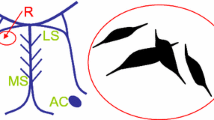Abstract
The electrophysiological properties of neurons of the medial septal nucleus and the nucleus of the diagnonal band of Broca (MS/DB) were studied using intracellular methods in urethane-anesthetized rats. Three types of rhythmically bursting neurons were identified in vivo on the basis of their action potential shapes and durations, afterhyperpolarizations (AHPs), membrane characteristics, firing rates and sensitivities to the action of muscarinic antagonist: (1) Cells with short-duration action potentials and no AHPs (2 of 34 rhythmic cells, 6%) had high firing rates and extremely reliable bursts with 6–16 spikes per theta cycle, which were highly resistant to scopolamine action. (2) Cells with short-duration action potentials and short-duration AHPs (8 of 34 rhythmic cells, 24%) also had high firing rates and reliable bursts with 4–13 spikes per theta cycle, phase-locked to the negative peak of the dentate theta wave. Hyperpolarizing current injection revealed a brief membrane time constant, time-dependent membrane rectification and a burst of firing at the break. Depolarizing current steps produced high-frequency repetitive trains of action potentials without spike frequency adaptation. The action potential and membrane and characteristics of this cell type are consistent with those described for GABAergic septal neurons. Many of these neurons retained their theta-bursting pattern in the presence of muscarinic antagonist. (3) Cells with long-duration action potentials and long-duration AHPs (24 of 34 rhythmic cells, 70%) had low firing rates, and usually only 1–3 spikes per theta cycle, locked mainly to the positive peak of the dentate theta rhythm. Hyperpolarizing current injection revealed a long membrane time constant and a break potential; a depolarizing pulse caused a train of action potentials with pronounced spike frequency adaptation. The action potential and membrane properties of this cell type are consistent with those reported for cholinergic septal neurons. The theta-related rhythmicity of this cell type was abolished by muscarinic antagonists. The phasic inhibition of ”cholinergic” MS/DB neurons by ”GABAergic” MS/DB neurons, followed by a rebound of their firing, is proposed as a mechanism contributing to recruitment of the whole MS/DB neuronal population into the synchronized rhythmic bursting pattern of activity that underlies the occurrence of the hippocampal theta rhythm.
Similar content being viewed by others
Author information
Authors and Affiliations
Additional information
Received: 5 February 1996 / Accepted: 6 November 1996
Rights and permissions
About this article
Cite this article
Brazhnik, E., Fox, S. Intracellular recordings from medial septal neurons during hippocampal theta rhythm. Exp Brain Res 114, 442–453 (1997). https://doi.org/10.1007/PL00005653
Issue Date:
DOI: https://doi.org/10.1007/PL00005653




